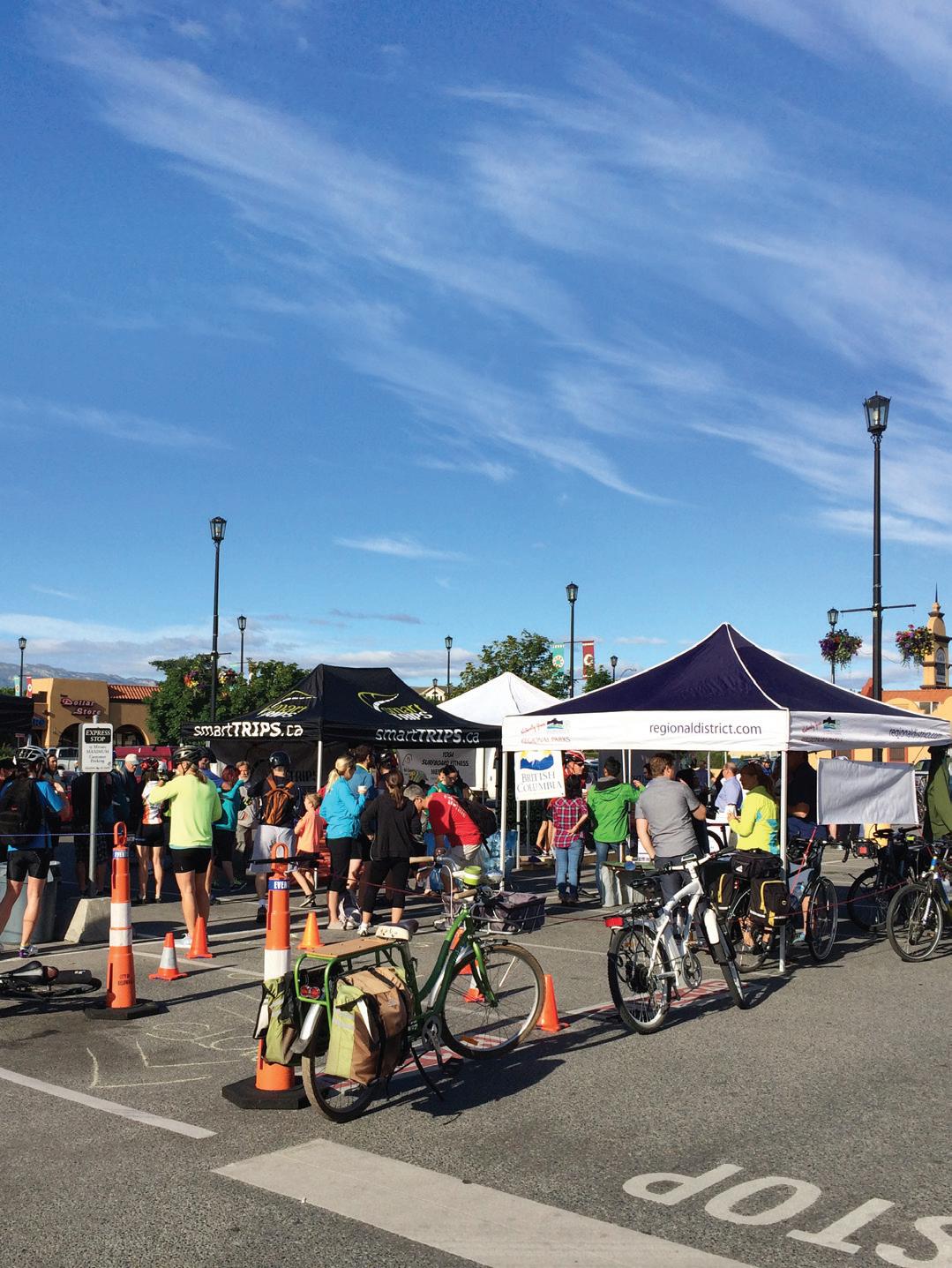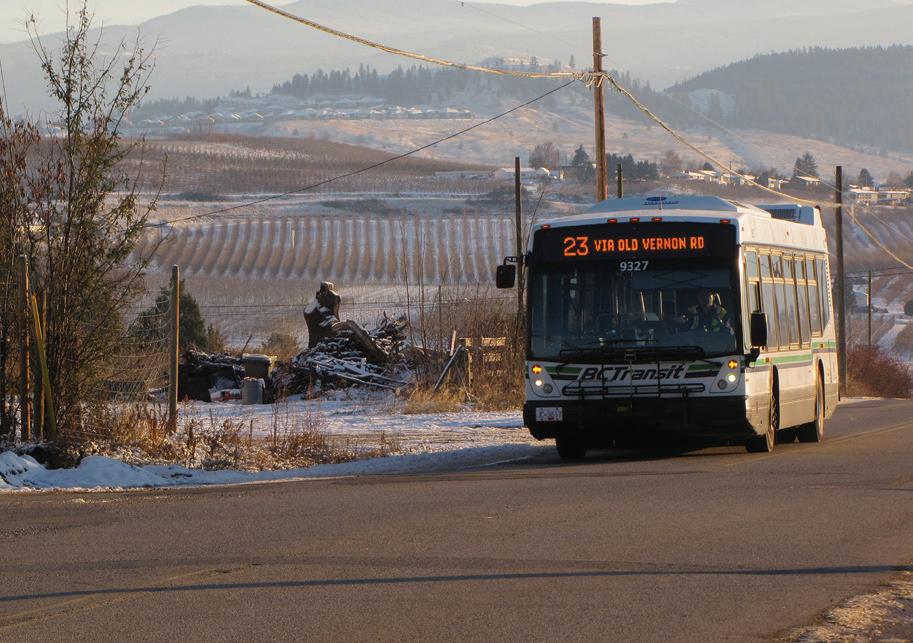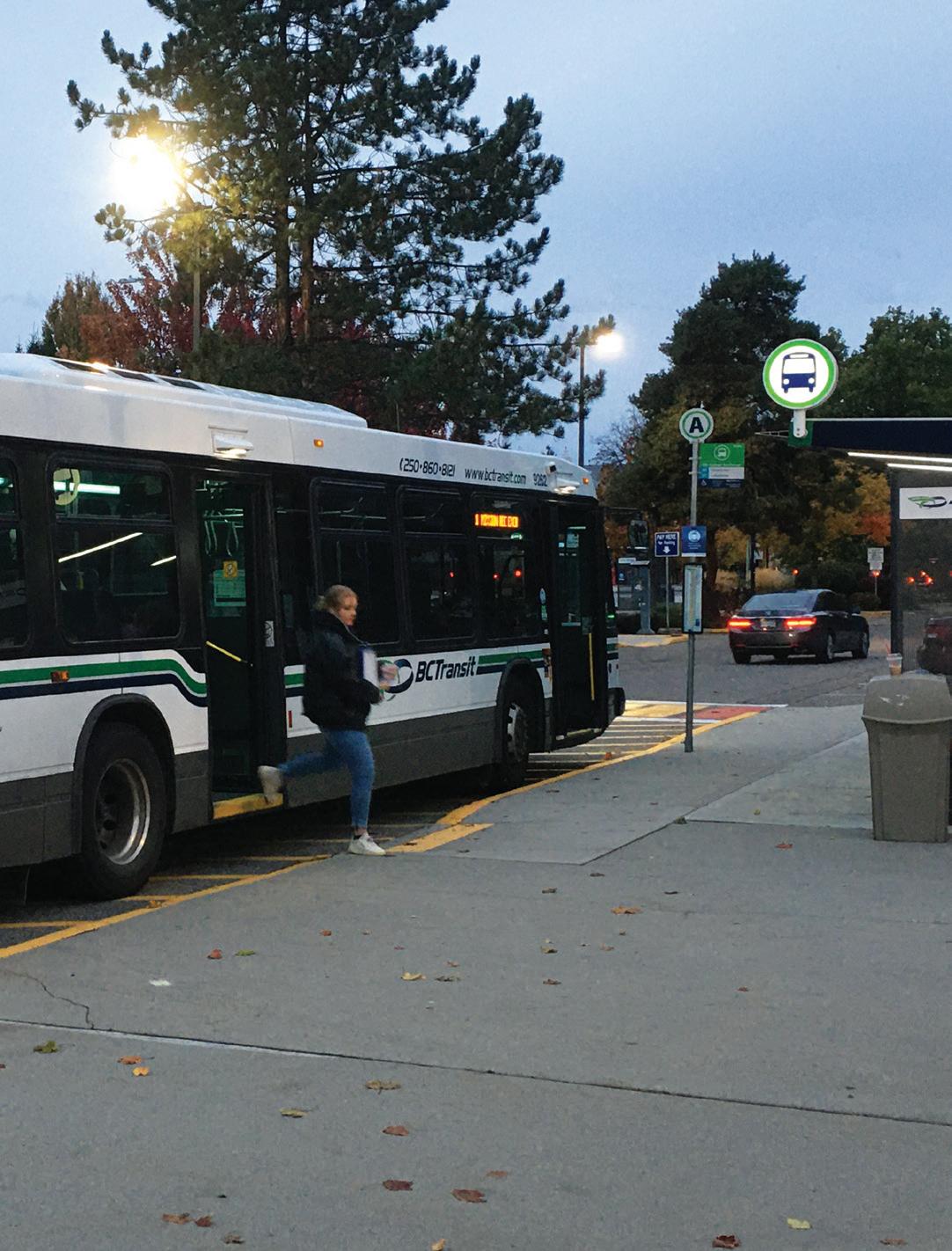
6 minute read
Transportation and mobility
We will promote transportation and land use approaches that enhance movement throughout the region and reduce our collective reliance on vehicles
Transportation is top of mind
This has been one of the key pillars of the Regional Board priorities as it mirrors the importance given the ability to get around the Central Okanagan in citizen surveys.
The first Regional District survey of residents in fall 2022 found more than nine-in-ten (92%) citizens say it is important to have a regional transportation function responsible for coordinating transportation across the region. And more than a third (37%) of respondents freely indicated that transportation is top of mind for them. Most often they cited concerns around traffic congestion, the condition of roads, highways and infrastructure and public transportation. As it turns out, the mentions of transportation in the Central Okanagan are higher than in other surveyed local governments (37% Central Okanagan vs. 22% municipal norm).
Reducing the number of fossil-fuel fired vehicles with viable alternatives helps improve the region’s air quality and reduces overall greenhouse gas emissions. This challenge faces everyone throughout the region, especially as we continue to see growth as people move from other parts of the country to call the Central Okanagan home.
The importance of transportation is not lost on local governments in the region. The Regional Growth Strategy states the goal of enhancing the region’s transportation system to ensure it’s accessible, affordable and efficient. Transportation doesn’t exist in a planning vacuum. Land-use influences travel patterns and transportation systems which in turn influence land use and development. Aligning land use and transportation strategies is key to achieving that goal. Much consideration is given to support efforts to shift the region’s travel patterns away from vehicle dependency toward moving people rather than vehicles. It’s known that when people live closer to work or school, they are able to make more trips by bike, walking or transit, resulting in less need for driving. Success requires consistent collaboration between local governments across the region. Partners must work together to effectively plan, coordinate, manage, and monitor the region’s transportation system to achieve sustainable transportation goals that are defined in the individual plans and policies of the local governments of the Central Okanagan.
We are seeing successes in this area including integration of active transportation trail systems and amenities, an emphasis on sustainable transportation that promote and support safe walking, cycling, public transportation and emerging technologies. In addition, it means working with the School District and parents to provide safe routes to schools.
Building out the Regional Transportation Plan
Building and maintaining a healthy, thriving and connected future for the Central Okanagan is the goal of the Regional Transportation plan and those that support it like the Regional Bicycling and Trails Master Plan and Regional Disruptive Mobility Strategy. Collectively, they identify transportation projects and priorities across the region and set the direction for local governments to work in unison to move people and goods efficiently, achieve fast and reliable transit, create a safe and convenient bicycling and trail network and adapt and incorporate new mobility options.
During 2022, the following initiatives were undertaken by Central Okanagan local governments to further support the regional transportation plan and related plans.
• Safe Routes 4 Schools: This program improves air quality at schools by reducing vehicle emissions and encouraging students to walk or bike. In 2022 the dedicated budget for engineering improvements was increased. School Travel Plans were completed at North Glenmore Elementary and Springvalley Elementary. Capital improvements were also completed at North Glenmore Elementary, including adding new bike lanes and a crosswalk on Snowsell Street.
• Improved Winter ATC Maintenance: In 2022, Kelowna focused on winter maintenance of the active transportation corridors that are used most and connect to key destinations. New equipment also made snow clearing quicker and more efficient.
City of Kelowna
In 2022, the City of Kelowna undertook several initiatives aligned with the Regional Transportation Plan and Regional Bicycling and Trails Master Plan.
• Regional Goods Movement Study: In 2022 the City of Kelowna partnered with the Province to conduct the Central Okanagan Regional Goods Movement Study. The study identified strategies to ensure the sustainable and efficient movement of goods as our region grows.
• Clement Ave extension. In 2022, the City of Kelowna received $600,000 from the Province to advance preliminary design of the Clement Ave Extension.
• City Park Waterfront Multi-use Path: The City of Kelowna widened the City Park waterfront multi-use pathway to accommodate the growing volumes of people walking and biking.
• Abbott Street Active Transportation Corridor (ATC): In 2022, Kelowna completed the extension of the Abbott Street Active Transportation Corridor from Kelowna General Hospital south to Cedar Avenue, providing connections to the Pandosy Urban Centre.
• Rutland to Rail Trail ATC: Complete in 2022, this project provides an all ages and abilities active transportation connection from Rutland to the Okanagan Rail Trail via Leathead Road.
• Shared E-Scooters and E-Bikes: In 2022 the City of Kelowna continued their participation in the provincial e-scooter pilot program. In 2022, approximately 240,000 trips were made by shared e-scooters and e-bikes, preventing 158,000 kilometres of driving and 30 tonnes of CO2 emissions.
City of West Kelowna
• Getting around West Kelowna is now easier with the addition of a roundabout at the Shannon Lake-Bartley-Stevens intersection. As part of this project, we added over two kilometres of bike lanes, sidewalks and street lights. By improving pedestrian and cycling access on Shannon Lake and Stevens Roads, we’ve provided a key connection to the West Kelowna Business Park – a major employment hub and transit corridor.
• The City’s Capital Works Crew was busy completing sidewalk connections on Shannon Ridge Drive and Shannon Way to expand the active transportation network in West Kelowna. Upgrades included 600 metres of sidewalks, street lighting and crosswalks.
• Design plans are also underway to address transportation upgrades to the Old Okanagan/Butt Road intersection.
District of Lake Country
• Lake Country plays an important regional role in providing an active transportation route that connects with the communities to the north and south and connects the region. A robust, contiguous local network benefits both Lake Country and the region by providing transportation routes and recreation and tourism connections and opportunities.
• Davidson Road improvements - This Transportation for Tomorrow improvement project was initiated as part of the safe routes to school initiative. The improvements help connect neighborhoods to Davidson Rd. school and included a sidewalk, curbing, road renewal and drainage upgrades between Camp Road and McGowan Road.
of surveyed Regional District residents
92%+ say we need coordinating regional transportation systems

Transit ridership recovering
It’s taken some time to see Central Okanagan residents return to seats on public transit buses following pandemic restrictions. The good news is that monthly ridership on Kelowna Regional Transit has almost recovered to levels seen before the pandemic. Regular service levels across the system returned for the spring season and ongoing staffing challenges were addressed throughout the year.
From 2021 to 2022, system-wide passenger trips rose more than 73% to more than 4.5 million on 29 routes using a fleet of 75 conventional and 12 community buses, along with 23 custom handyDART vehicles. In 2019, ridership topped 5.9 million.
During the year, residents in several Kelowna communities had the opportunity to share their thoughts about potential transit options for future transit services in the Kettle Valley, Mission and Rutland areas. Their feedback through BC Transit surveys will be considered as BC Transit develops future service changes and priorities for infrastructure improvements.
Improving the experience of those using Kelowna transit is an ongoing process involving six local government funding partners and BC Transit. One of the ways BC Transit helped attract people and build future generations of transit riders for life was through the introduction of the Free Transit for Children 12 and Under program. It offers complimentary bus travel to children across the system.
In addition, the popular GradPASS program returned ahead of the graduation season for Grade 12 students in the Central Okanagan, allowing them to ride Kelowna Regional Transit buses for free any two days of their choice during June. Each student received a card that when shown to a bus driver along with their valid student ID offered their free rides.
It’s anticipated in late 2023 as part of the BC Transit province-wide rollout of the contactless Umo electronic fare collection system, Kelowna Regional Transit riders will be able to pay their fare using a mobile app, reloadable smart card as well as credit and debit cards and cash, providing riders with the ability to pick the best payment method for their lifestyle and travel habits. The new electronic Umo technology will increase access to transit by allowing riders to use items they carry every day, removing barriers like requiring them to prepurchase tickets and passes or carry exact change. While cash will continue to be accepted for those riders who prefer to use it, it’s anticipated that most will find one of the new payment methods as a more convenient option.
29 bus routes had more than 4.5M riders in 2022










